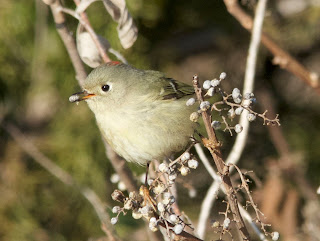Courtesy Timothy Barksdale
One of the smallest birds, this nervous-appearing, constant wingflicker in continual motion possesses olive-green plumage with a pale eye ring, thin dark bill and legs with pale feet. Often confused with a warbler, this solitary bird often joins chickadees, titmice, warblers, and other small songbirds of the wood. When agitated or excited, the adult male will flick its bright red crown. It also has a dark bar on the base of its secondary feathers and appears to be a warbler or a tiny flycatcher with its rapid movement.
It has a loud, complex, and highly variable confusing song, and lays the largest clutch of eggs for its size, numbering up to a dozen. This songbird breeds in the western mountains of the US and the northeast, but mainly attends nests in the Boreal Forest of Canada. It breeds high within spruce-fir forests which lends difficulty to its breeding habits. They do favor mixed forest and old growth habitat. The adult male arrives first upon breeding territory and leaves last in the fall, even later than the juveniles of that season.
Ruby-crowned Kinglet
Boomer Creek Park, January 2016
In the winter, it prefers thick understory. Having studied the species extensively in the Boomer Creek area over several years (2015-early 2018), it was found that they will readily habituate to humans. One particular male would appear when called and was very amicable to numerous photographs, coming very close. However when disturbed by loud traffic and other abnormal non-forest noises, it would disappear, but return quickly. It never remained in the area longer than ten days. Its song consisted of rapid warbles, clear notes, and whistles, lasting approximately six seconds. Its song is so loud, one expects much larger than a four-inch bird.
The songbird enjoyed small insects and readily investigated old spider egg sacs, as well as red cedar fruit, and sally out after gnats or similar insects.
At Boomer Lake, another individual male bird was observed during the same period in 2016, which had a personality nothing like the original kinglet. It was shy and retiring, never singing, making observation much more difficult. It was not in the area longer than three days.
Most birds of the western part of the country will remain there, but many of the northernmost breeders will continue on to southern Mexico or slightly beyond for migration. Oklahoma's birds can be observed for the entire winter and into early spring.
For More Photos of Ruby-crowned Kinglet, See:
https://debhirt.blogspot.com/2016/01/as-cool-wind-blows-stars-come-out-of.html
https://debhirt.blogspot.com/2016/01/steady-as-westerly-wind-blows.html

No comments:
Post a Comment